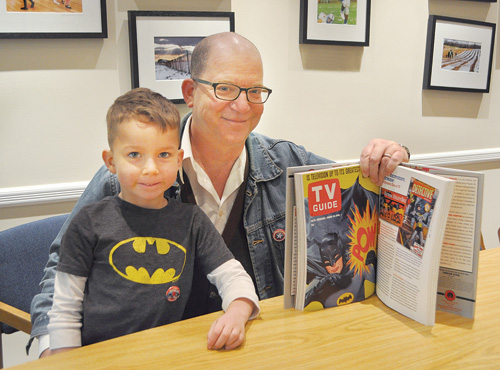Local resident co-authors book on comic history

When the television series “Batman” premiered in 1966, Laurence Maslon was hooked instantly.
Mr. Maslon, 54, described himself as a “Bat-maniac” when the show came out, and recently penned a book to prove it. The part-time Southold resident co-authored the 304-page “Superheroes! Capes, Cowls, and the Creation of Comic Book Culture” with Michael Kantor.
The book, a full-color companion volume to the three-part PBS documentary “Superheroes: A Never-Ending Battle,” which aired in October, tracks the history of comic book culture from its start in 1938 with the birth of Superman to its formidable presence today as a multibillion dollar industry.
“There weren’t a lot of superhero books when I was growing up,” said Mr. Maslon, who also teaches in the graduate acting program at New York University’s Tisch School of the Arts. “Basically, I wrote the book I wanted to read when I was 12.”
Q: Have you always had an interest in comic books/superheroes?
A: Yeah. I remember being 6 when Batman came on TV in January 1966. I guess I sort of knew a little bit about comic books and stuff but that’s what really sold me. I just was a total “Bat-maniac” and wanted the utility belt and the Batmobile and all that stuff for Christmas. I very quickly got into all the rest of the comic books.
Q: Do readers need to have a deep understanding of comic book culture to enjoy this book?
A: I think you’d have to be living in a cave, and not even a Bat Cave, to not know something about at least one or two of these characters. They’re ubiquitous and this story tells you how we got to that point, from 1938 to today, where they’ve just subsumed every aspect of American pop culture.
Q: If you could have one superpower, what would it be?
A: Well, certainly in junior high school it would have been invisibility but that may have been because of the girls’ locker room. There’s something always appealing about speed. I think maybe deep down every kid wants to be able to run faster than any kid in gym class.
Q: Who is your favorite superhero, and why?
A: My favorite is actually a pre-super hero named Doc Savage. He was a pulp hero in the 1930s and was the precursor to Superman. He was a normal guy but he was an autodidact – he taught himself 20 languages, did calisthenics three hours a day, learned every form of combat there was and was smart enough to perform brain surgery on criminals and change their ways. The kinds of heroes I tend to like are what I call “Do it Yourselfers.” Batman is a great example. Not people who come from another planet or are hit by a lightning bolt or are Amazonian princesses but people who work really, really hard at being the best they can be and devote their time to serving others. As I like to say, there’s no human resources office for superheroes. All these guys and gals volunteer one way or another to save the world, and that’s a noble calling.
Q: What was the most challenging part of writing this book?
A: Hard-core superhero fans are a very exacting bunch. They were more negative about this project than I expected them to be and that surprised me. I think because we tried to put out a type of book that was comprehensive, if not definitive, I think a lot of fans felt like, “Well, we knew that already.” But I think that’s a little bit disingenuous because we interviewed over 50 people, many of whom started the comic book industry back in the early ’40s — so no one could know everything that’s in the book.
Q: Why do you think comic superheroes have made such an impression on American culture?
A: As human beings, we are constantly surrounded by things we can’t answer, so we sometimes go to superheroes who can answer things for us. I mean, there’s no superhero called Legislature Man.


